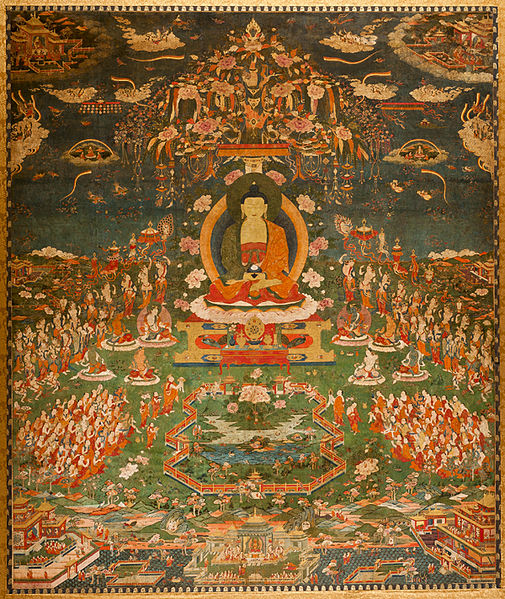Is This World a Pure Land?
by Kaspa

The Pure Land of Amitabha is described as a land without hell realms, without suffering. It is described as a place where enlightenment comes easily, where Amitabha sits radiantly in the centre. It is a land of jewelled trees, limpid bathing pools, giant lotus flowers and musical instruments that play themselves.
It is called Sukhavati, which means place of joy.
Some people take these descriptions literally; many take them as an attempt in words to evoke something transcendental: a realm of love.In classical Pure Land Buddhism devotees go to Sukhavati after their death. But could this world be the Pure Land?
Amitabha’s Pure Land is a place of no hell realms and no suffering. The first noble truth of Shakyamuni Buddha was that of Dukkha — that to be born into this world one inevitably suffers. Is it possible to reconcile these differences?
Buddhism often breaks suffering into two halves: in the first half the suffering in the world, the external conditions that change, loss and illness and death; in the second half our own response to that suffering. If we practise diligently we can transform how we respond to suffering.
Perhaps that offers a way of seeing this world as the Pure Land? When we are enlightened, nothing we experience creates suffering. Is that really true though? Practice can ease anguish, and soften the highest peaks and deepest lows of our emotions, but it shouldn’t undermine the appropriate sadness, grief and recognition of real suffering in the world.
I think the distinction between Amitabha’s Pure Land as a place of pure joy and our world is an important one. We stand here and are inspired by our vision of the Pure Land. We know there is a world that will receive us just as we are, and that a world where all beings are loved by each other is possible, even if it isn’t here.
But Buddhism speaks of many Pure Lands, many Buddha fields, not just the world of Amitabha, and some of those do contain hell realms.
Is this world the same as Sukhavati? No. Could it be a Pure Land? Yes.
A Pure Land is any place with a Buddha in the centre. It is the field of influence around that Buddha. The land and the living beings around that Buddha are transformed by its presence: by its love.
Amitabha lives in Sukhavati, but their light reaches to all worlds. If we centre our lives upon that light, we begin to experience the effects of being close to a Buddha, and a Pure Land begins to appear.
If we strip out all of the Buddhist language where does that leave us? That there is a realm of pure love and joy that exists alongside ours, and that the more we let that love into our lives, the more the world around us comes to resemble that place.
